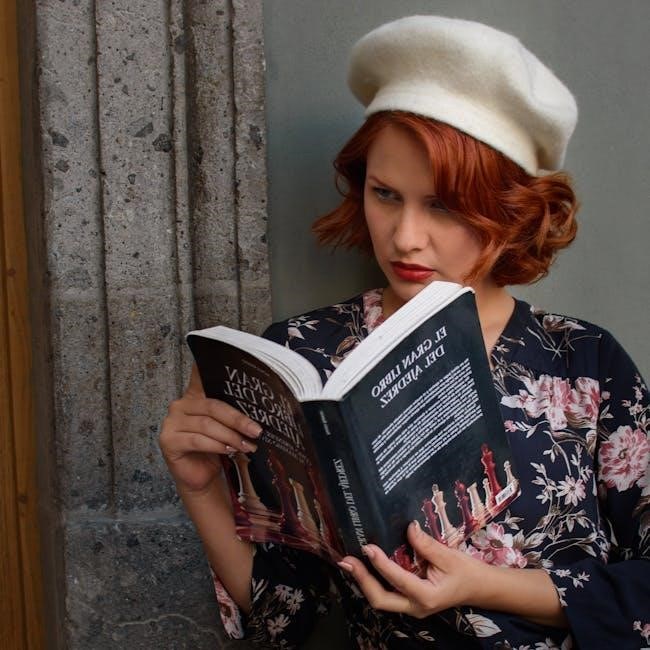Malcolm Gladwell’s Blink explores the power of rapid decision-making, revealing how instincts shape our choices. This groundbreaking book bridges science, psychology, and everyday experiences, offering insights into the unconscious mind’s remarkable abilities and limitations.
1.1 Overview of the Book
Blink: The Power of Thinking Without Thinking by Malcolm Gladwell delves into the concept of rapid decision-making, exploring how instincts and first impressions influence our choices. The book examines the “adaptive unconscious,” a mental process that enables quick judgments with limited information. Through compelling case studies, such as an art dealer’s intuition about an ancient statue, Gladwell illustrates how experts often make accurate decisions unconsciously. He argues that while these instincts can be powerful, they are not infallible, highlighting the fine line between intuition and error. By blending psychology, neuroscience, and real-world examples, Blink challenges readers to rethink the way they make decisions, offering a deeper understanding of the unconscious mind’s role in everyday life.
1.2 Author Background: Malcolm Gladwell
Malcolm Gladwell, a renowned Canadian journalist and author, has captivated readers with his unique ability to blend storytelling and scientific insights. Born in 1963 in England, Gladwell began his career in journalism, eventually joining The New Yorker as a staff writer. His books, such as The Tipping Point and Blink, have become international bestsellers, earning him widespread acclaim for his exploration of human behavior, decision-making, and cultural phenomena. Gladwell’s work is celebrated for its accessibility and depth, making complex ideas relatable to a broad audience.
1.3 Why “Blink” is Significant
Blink is significant for challenging conventional wisdom about decision-making. Gladwell argues that rapid, intuitive judgments, often made in seconds, can be as accurate as deliberate, reasoned decisions. By exploring the adaptive unconscious and thin-slicing, the book offers practical insights into harnessing intuition in professional and personal settings. Its impact extends across various fields, influencing business strategies, leadership, and everyday choices, making it a transformative read for understanding human cognition and behavior.

Key Concepts Explored in “Blink”
The book delves into the power of first impressions, thin-slicing, and the adaptive unconscious, revealing how rapid decisions can be as effective as deliberate ones.
2.1 The Power of First Impressions
Blink highlights the profound impact of first impressions, formed in mere seconds, often unconsciously. Gladwell illustrates this with the story of an art dealer who instantly recognized a statue’s inauthenticity. These rapid judgments, rooted in the adaptive unconscious, can be remarkably accurate, shaping decisions in ways that conscious deliberation may not. The book argues that such snap decisions are not just intuitive but often reliable, challenging the notion that more time equals better outcomes.

2.2 Thin-Slicing: Making Decisions with Limited Information
Gladwell introduces “thin-slicing,” the ability to make accurate decisions using limited information. This concept, central to Blink, explains how experts often rely on subconscious patterns from extensive experience to make rapid judgments. For instance, psychologists can predict marital success by observing brief interactions, showcasing how fragmented data can yield profound insights. Thin-slicing highlights the brain’s extraordinary capacity to extract meaningful signals from noise, even without conscious analysis, challenging traditional notions of decision-making.
2.3 The Adaptive Unconscious
The adaptive unconscious refers to the brain’s ability to process information rapidly, often beneath conscious awareness. Gladwell illustrates how this mental system enables quick decisions by focusing on patterns and cues, bypassing deliberate reasoning. For example, experts like art historians can instantly identify forgeries due to subconscious pattern recognition. This concept challenges traditional views of decision-making, emphasizing the power of instinct over deliberate analysis and highlighting its role in both success and potential biases.
Case Studies and Examples
“Blink” features real-world examples, such as an art dealer’s intuition about an ancient statue, demonstrating how rapid decisions can be remarkably accurate, validating Gladwell’s theories on intuition and expertise.
3.1 The Art Dealer and the Ancient Statue
In Blink, Gladwell recounts the story of Gianfranco Becchina, an art dealer who instinctively identified a fake ancient statue. Despite its convincing provenance, Becchina’s trained eye detected discrepancies, later confirmed by scientific tests. This case highlights the power of expertise and rapid judgment, showcasing how professionals can make accurate decisions without conscious reasoning. Gladwell uses this example to illustrate the concept of “thin-slicing,” where experts extract meaningful patterns from minimal information, reinforcing the book’s central theme of intuitive decision-making.
3.2 The Psychology of Intuition in Expertise
Gladwell examines how expertise fosters intuition, enabling swift, accurate decisions. Experts’ subconscious processes, shaped by experience, allow them to “thin-slice” information, making judgments without conscious thought. The adaptive unconscious rapidly analyzes patterns, often more effectively than deliberate reasoning. Gladwell illustrates this with experts like art dealers and psychologists, showing how practice refines intuition. However, he also notes intuition’s limitations, emphasizing the need for balance between trusting instincts and critical evaluation in professional settings to enhance decision-making accuracy.
3.4 The Limitations of Blinking: When Intuition Fails
Gladwell highlights cases where intuition misleads, such as the Getty Museum’s purchase of a fake statue. Experts, despite their expertise, can be deceived due to biases or incomplete information. He emphasizes that while “blinking” is powerful, it is not infallible. Cultural biases, emotional distortions, and lack of context can lead to errors. Gladwell advocates for balancing intuition with deliberate analysis, especially in high-stakes decisions, to mitigate these limitations and ensure more accurate outcomes in both personal and professional realms.

The Science Behind Blinking
Blink delves into the neuroscience of rapid decision-making, exploring the brain’s adaptive unconscious and its role in processing information swiftly, often beyond conscious awareness. Behavioral economics further explains how these intuitive processes shape human behavior and choice.
4.1 Neuroscience and the Brain’s Decision-Making Processes
Blink examines how the brain’s adaptive unconscious enables rapid decision-making through neural pathways that process patterns and experiences subconsciously. Gladwell highlights how the amygdala and other brain regions trigger instantaneous reactions, often before conscious thought. This process, rooted in evolutionary biology, allows experts to “thin-slice” information, making accurate judgments with minimal data. However, biases and emotional triggers can sometimes lead to errors, illustrating the complex interplay between instinct and reason in human cognition.
4.2 Behavioral Economics and Rapid Decision-Making
Blink integrates behavioral economics to explain how rapid decisions often align with rational choices. Gladwell illustrates that snap judgments can be as effective as deliberate ones, leveraging heuristics like “thin-slicing.” These mental shortcuts allow experts to filter noise and focus on critical cues. Behavioral economics supports this by showing that quick decisions tap into subconscious patterns, highlighting the efficiency of intuition in uncertainty. This challenges traditional views of decision-making, emphasizing the mind’s ability to prioritize without conscious oversight.
The Writing Process and Research
Gladwell’s meticulous research and storytelling craft shaped Blink, blending psychology, neuroscience, and real-world examples to create a compelling narrative about rapid decision-making and intuition.

5.1 Gladwell’s Approach to Storytelling

Gladwell masterfully blends storytelling with scientific research, making complex concepts accessible. He uses anecdotes, like the art dealer and the ancient statue, to illustrate intuition’s power. His engaging narrative style, combining psychology and real-world examples, captivates readers. By structuring the book around relatable stories, Gladwell transforms abstract ideas into tangible insights, ensuring Blink appeals to a broad audience while maintaining intellectual depth and clarity.
5.2 The Role of Research in Shaping the Book’s Narrative
Gladwell’s research is the backbone of Blink, weaving together psychology, neuroscience, and real-world examples. He draws on studies like John Bargh’s experiments on unconscious influences and expert intuition in fields like art and medicine. By synthesizing diverse sources, Gladwell crafts a compelling narrative that validates his thesis on rapid decision-making. His meticulous research ensures the book’s authority, blending scientific rigor with accessible storytelling to engage readers and build credibility.

Reception and Impact

Blink received widespread critical acclaim, influencing business strategies and popular culture. Its insights sparked debates, solidifying Gladwell’s impact on decision-making discussions globally.
6.1 Critical Acclaim and Reviews
Blink garnered widespread critical acclaim for its insightful exploration of rapid decision-making. Reviewers praised Gladwell’s ability to make complex psychological concepts accessible, blending compelling anecdotes with scientific research. The book was hailed as a breakthrough in understanding intuition and its role in professional and personal life. Its engaging narrative and thought-provoking ideas solidified its status as a bestseller, resonating with audiences worldwide and leaving a lasting impact on decision-making theories in various fields.
6.2 Controversies and Criticisms
Despite its popularity, Blink faced criticism for oversimplifying the complexity of intuition. Some experts argued that Gladwell’s emphasis on rapid decision-making overlooked the role of deliberate analysis. Critics like Kevin J. Clancy and Peter C. Krieg contended that intuition is not always reliable and can lead to errors. Additionally, the book was criticized for not adequately addressing the limitations of “thin-slicing” in contexts where cultural biases or emotional influences may skew judgment. These critiques highlight the need for a balanced approach to decision-making.
6.3 The Book’s Influence on Popular Culture and Business
Blink has significantly influenced popular culture and business practices by popularizing the concept of rapid decision-making. It inspired discussions on intuition’s role in leadership and everyday life. The book has been widely referenced in media, education, and corporate training, encouraging professionals to trust their instincts while remaining aware of biases. Its ideas have also shaped strategies in marketing, healthcare, and technology, making it a foundational text for understanding the power of first impressions and intuitive thinking in modern society.

Practical Applications of Blink
Blink offers practical insights into enhancing intuition, improving rapid decision-making, and avoiding cognitive biases. Its principles are applied in fields like business, education, and healthcare, helping professionals make smarter, faster choices while minimizing errors.
7.1 Enhancing Intuition in Professional Settings
Professionals can leverage the principles of Blink to enhance intuition by trusting their instincts in high-pressure situations. By recognizing patterns and thin-slicing, experts can make rapid, accurate decisions. Gladwell’s insights encourage professionals to embrace their adaptive unconscious, reducing overthinking and improving efficiency. Training through exposure to diverse scenarios and feedback can further refine intuitive skills, making them invaluable in fields like healthcare, finance, and leadership; This approach fosters confidence and accuracy in decision-making processes.
7.2 Training the Adaptive Unconscious
Training the adaptive unconscious involves honing intuition through deliberate practice and exposure to diverse experiences. By engaging in mental exercises and learning to trust first impressions, individuals can refine their ability to thin-slice. Gladwell highlights that experts develop this skill through extensive practice, allowing their unconscious to recognize patterns quickly. Regular feedback and reflection on decisions can further enhance this ability, making the adaptive unconscious a powerful tool for rapid, accurate judgments in both personal and professional contexts.
7.3 Avoiding Pitfalls in Decision-Making
While intuition can be powerful, it is not infallible. Gladwell warns against biases and limited information skewing decisions. He emphasizes the importance of awareness of personal biases and testing assumptions. Additionally, seeking diverse perspectives and delaying decisions when uncertainty is high can mitigate errors. Understanding these pitfalls helps individuals balance intuition with deliberate reasoning, fostering more reliable decision-making processes in both professional and personal contexts.

Availability of “Blink” in PDF Format
Blink is widely available in PDF format on platforms like ResearchGate and through direct download links. Ensure legal and ethical considerations when accessing copyrighted material online.
8.1 Where to Find the PDF Version
The PDF version of Blink: The Power of Thinking Without Thinking can be found on various online platforms, including ResearchGate, PDFRoom, and Course-Notes.Org. It is also available through direct download links on websites like Bestbookbits and academic repositories. Additionally, summaries and excerpts from the book can be accessed on platforms such as Academia.edu and Scribd. Ensure to verify the legality and authenticity of the source before downloading any copyrighted material.
8.2 Legal and Ethical Considerations ofDownloading the PDF
8.2 Legal and Ethical Considerations of Downloading the PDF
Downloading a PDF of Blink: The Power of Thinking Without Thinking may violate copyright laws if obtained from unauthorized sources. Respect intellectual property by purchasing the book from reputable retailers or borrowing it legally. Pirating copyrighted material undermines authors and publishers, who rely on sales for their livelihood. Always opt for ethical and lawful access to support creators and adhere to legal standards.
Blink reshapes our understanding of intuition and rapid decision-making, emphasizing the power of the adaptive unconscious. Its insights have profoundly influenced popular culture and professional strategies globally.
9.1 Summary of Key Takeaways
Blink highlights the power of rapid decision-making, introducing concepts like thin-slicing and the adaptive unconscious. It shows how first impressions can be surprisingly accurate but also prone to biases. Gladwell emphasizes that intuition, while powerful, requires expertise and context to function effectively. He also warns about the dangers of ignoring subconscious biases, illustrating when and why “blinking” can fail. Ultimately, the book challenges readers to trust their instincts while remaining mindful of their limitations.
9.2 The Lasting Legacy of “Blink”
Blink has left a lasting impact on how we understand decision-making and intuition. Its concepts, like thin-slicing and the adaptive unconscious, have influenced fields from business to psychology. While some critics argue its ideas are oversimplified, the book remains a cultural touchstone, sparking debates about the role of intuition in society. Gladwell’s work continues to inspire research and reflection, cementing Blink as a foundational text in modern thought on rapid cognition and its complexities.
References and Further Reading
- ResearchGate: Access to Malcolm Gladwell’s Blink summaries, academic discussions, and related research papers.
- PDF Summaries: Free downloadable summaries of Blink for quick insights into its key concepts.
- Book Reviews: Critical analyses and reviews from publications like The New Yorker and academic journals.
- SparkNotes: Detailed study guides and analyses of Blink for educational purposes.

